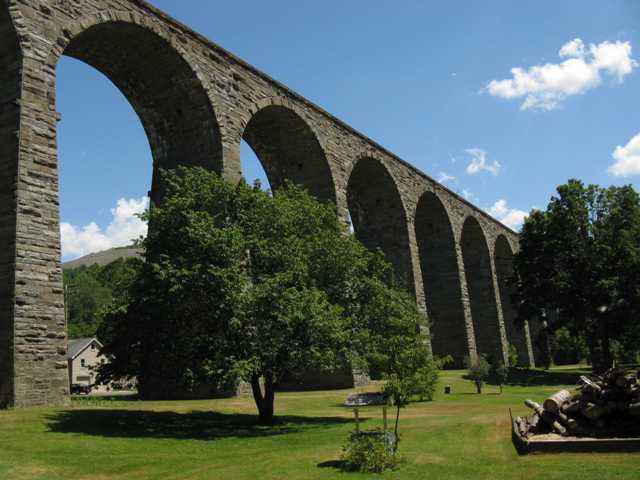We Recommend:
Bach Steel - Experts at historic truss bridge restoration.
BridgeHunter.com Phase 1 is released to the public! - Visit Now
Starrucca Viaduct

Primary Photographer(s): Robert Theobald
Bridge Documented: Summer 2010
Railroad (Erie Railway) Over Starrucca Creek, Railroad, and Highways
Lanesboro: Susquehanna County, Pennsylvania: United States
1848 By Builder/Contractor: Unknown and Engineer/Design: J. P. Kirkwood and J. W. Adams
Not Available or Not Applicable
51.0 Feet (15.5 Meters)
1,040.0 Feet (317 Meters)
26 Feet (7.92 Meters)
17 Main Span(s)
Not Applicable

View Information About HSR Ratings
Bridge Documentation
View Historic American Engineering Record (HAER) Documentation For This Bridge
HAER Drawings, PDF
This magnificent structure stands today, not only as one of the oldest and largest railroad bridges in Pennsylvania, but as one of the most impressive and noteworthy examples of a stone bridge in the United States. The bridge soars 100 feet over the valley it crosses, with semicircular stone arch spans supported by stone piers. This bridge was among the last of its kind to be built in the United States, for soon after, metal would become the preferred material for structures of this size. A mighty structure, the bridge today retains excellent historic integrity and is largely unaltered, yet is capable of carrying four times the weight of any train that would have existed in 1848. This bridge is very impressive in appearance and has been compared to Roman aqueducts in terms of visual appearance. The bridge has received designation as a National Historic Civil Engineering Landmark, a designation that very few bridges receive.
Aside from its size and age, the Starrucca Viaduct is noteworthy for its unique design and construction. Review the Historic American Engineering Record drawings for a description of these unusual and noteworthy details. Among the details, the interior of the arch has voids designed to reduce the dead load on the arch. Also, concrete was used in the pier foundations, which would have been an experimental endeavor at the time. Also, the bridge has a 1 degree incline, but was carefully designed to give the illusion of a horizontal bridge.
![]()
Photo Galleries and Videos: Starrucca Viaduct
Bridge Photo-Documentation
Original / Full Size PhotosA collection of overview and detail photos. This gallery offers photos in the highest available resolution and file size in a touch-friendly popup viewer.
Alternatively, Browse Without Using Viewer
![]()
Bridge Photo-Documentation
Mobile Optimized PhotosA collection of overview and detail photos. This gallery features data-friendly, fast-loading photos in a touch-friendly popup viewer.
Alternatively, Browse Without Using Viewer
![]()
Maps and Links: Starrucca Viaduct
Coordinates (Latitude, Longitude):
Search For Additional Bridge Listings:
Bridgehunter.com: View listed bridges within 0.5 miles (0.8 kilometers) of this bridge.
Bridgehunter.com: View listed bridges within 10 miles (16 kilometers) of this bridge.
Additional Maps:
Google Streetview (If Available)
GeoHack (Additional Links and Coordinates)
Apple Maps (Via DuckDuckGo Search)
Apple Maps (Apple devices only)
Android: Open Location In Your Map or GPS App
Flickr Gallery (Find Nearby Photos)
Wikimedia Commons (Find Nearby Photos)
Directions Via Sygic For Android
Directions Via Sygic For iOS and Android Dolphin Browser
USGS National Map (United States Only)
Historical USGS Topo Maps (United States Only)
Historic Aerials (United States Only)
CalTopo Maps (United States Only)


